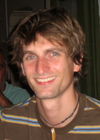Deformable Guide Wire TrackingScientific Director: Nassir NavabContact Person(s): Hauke Heibel |
Abstract
These days, X-ray fluoroscopic imaging is the modality used most widely to guide physicians in angiographic interventions. Current guidance procedures are based on a roadmap, e.g. a digital subtracted angiography (DSA) acquired from a fixed viewpoint and the injection of contrast agent to visualize the current vessel anatomy. Such roadmaps cannot directly be blended with the fluoroscopic sequence due to misalignment caused by respiratory motion. A fundamental step toward a successful integration of any navigation application into clinical routine is the estimation and compensation of respiratory motion. We propose a novel method for deformable tracking of multiple ridge segments based on a MAP-MRF formulation and efficient discrete optimization. Ridges are modeled as B-Spline curves which allows us to apply smooth deformations based on a minimal number of parameters. Our tracking framework is well adapted to the noisy domain of fluoroscopic imaging and the handling of multiple segments.Publications
| 2012 | |
| H. Heibel, B. Glocker, M. Groher, M. Pfister, N. Navab
Interventional Tool Tracking using Discrete Optimization IEEE Transactions on Medical Imaging (TMI) (bib) |
|
| 2010 | |
| H. Heibel, B. Glocker, N. Paragios, N. Navab
Needle Tracking Through Higher-Order MRF Optimization IEEE International Symposium on Biomedical Imaging (ISBI), Rotterdam, The Netherlands, April 14 - 17 2010. (bib) |
|
| 2009 | |
| H. Heibel, B. Glocker, M. Groher, N. Paragios, N. Komodakis, N. Navab
Discrete Tracking of Parametrized Curves IEEE Computer Society Conference on Computer Vision and Pattern Recognition (CVPR), Miami, Florida (USA), June 2009. (bib) |
|
Team
Contact Person(s)
|
Working Group
|
|
|
Location
| Technische Universität München Institut für Informatik / I16 Boltzmannstr. 3 85748 Garching bei München Tel.: +49 89 289-17058 Fax: +49 89 289-17059 |
internal project page
Please contact Hauke Heibel for available student projects within this research project.


